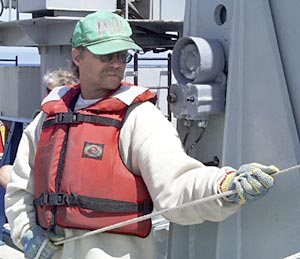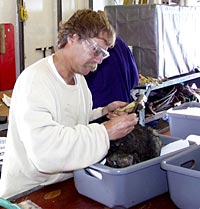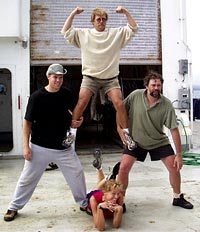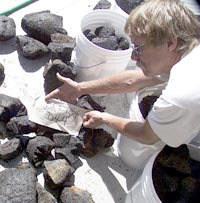Galápagos Islands
Expedition 5:
Aug 23-Sep 24, 2001
Mission & Objectives
Daily Updates
Mail Buoy
Scientists & Crew
Interviews
Hot Topics
Slideshows
Videos
Activities
Glossary
|
Interviews: Geologist Bob Reynolds
 Holding a tag line tight, Bob helps deploy the rock dredge. Holding a tag line tight, Bob helps deploy the rock dredge.
Bob Reynolds had to make an important decision. The year
was 1990 and he had just completed his master’s degree in geology
from the University of Idaho. He had spent 13 years in the petroleum
industry drilling for oil and was now looking to start work in the
mining industry. That’s when Denny Geist arrived in town from Hamilton
College, in Clinton, N.Y. “I was new to the University of Idaho
and I was looking for a good student,” Denny says.
 |
 |
| Bob chips glass off rock samples in the hangar. |
Denny
offered Bob a research project working in the Galápagos mapping
geologic features that had never been mapped before. “I weighed
the decision for about two weeks,” Bob says. It would mean starting
a Ph.D. thesis at the age of 36 and he wasn’t sure what his employment
opportunities would be when he finished. “I’ve always believed
that education provides opportunities and, if you don’t do it, those
opportunities won’t be there for you,” Bob says. “I thought
the Galápagos was a once in a lifetime opportunity, and, in
the mining industry, I would probably never have the chance to travel
there.” He accepted Denny's offer.”This is now my sixth
trip.”
The
logistics of planning that first expedition, to Isabela’s Sierra Negra
volcano, was “probably most challenging experience I’ve had,”
Bob says. “I didn’t know what to expect. We had no automobiles,
and had to move everything either by horse or carry it. I had a student
from Ecuador and it was just the two of us for a month by ourselves.
We ate mostly crackers and canned tuna, rice and oatmeal.
 |
 |
| Los Tiberones performing their pyramid routine with Bob in the middle. |
“It’s
very different working on land in the Galápagos than at sea.
We could see the outcrops, so it’s not quite the guessing game it
is when you’re looking at it through 3,000 meters of water. But the
trouble was walking. Sierra Negra is mostly a’a lava, which is loose,
crumbly and painful to walk across. Your knees, ankles and feet are
always at odd angles, twisting and turning. You’re constantly losing
your footing.
“We would start at 7 a.m. and work till 4 p.m. collecting samples.
At night on Sierra Negra we would camp on the summit in the garúa
cloud banks. The garúa can be pretty miserable stuff: windy
and wet and everything is damp. The only other place as harsh and
remote is the high Arctic of northern Canada.”
Bob is able to make the comparison because he spent six years in the
petroleum industry drilling through the ice sheets of the Arctic Ocean
into the seafloor. He was working on wildcat oil wells. The operations
would wait until winter, when the ice was locked together. “We
were sitting on a frozen sea,” he says. “;It was really odd,
to fly from Calgary and land on a piece of ice. It was not always
smooth ice, sometimes it would be crumpled in ridges, but all you
could see for as far as you could see was ice. You got the feeling
you were somewhere distant, truly exotic, but not where everyone would
want to go. It was really raw nature.”
 |
 |
|
Bob helps catalog the rock samples from dredge 44. |
 |
Other oil jobs took Bob - a native of Titusville, Penn., the birthplace
of the oil industry in America - to Colombia, Venezuela, Brazil,
Scotland, Ireland and Italy. “I would always travel on my own
by bus after a job to see the country,” Bob says. Now, as a
professor of Geology and Oceanography at Central Oregon Community
College, Bob travels with his students to the local lakes and volcanoes.
Newberry Volcano near Bend is a national monument with two lakes
that he and his students are studying. “The college has a 22
foot boat and the students do the same thing we’re doing here in
the Galápagos.” With smaller cranes and dredges, they
sample for rocks and with a sediment core look for layers of ash,
shells and other volcanic debris.
Now, when Bob’s not hiking, sampling or sailing around Galápagos
volcanoes, he’s SCUBA diving the ancient volcanic lakes in Oregon
or telemark skiing their slopes.
|

 Holding a tag line tight, Bob helps deploy the rock dredge.
Holding a tag line tight, Bob helps deploy the rock dredge.

